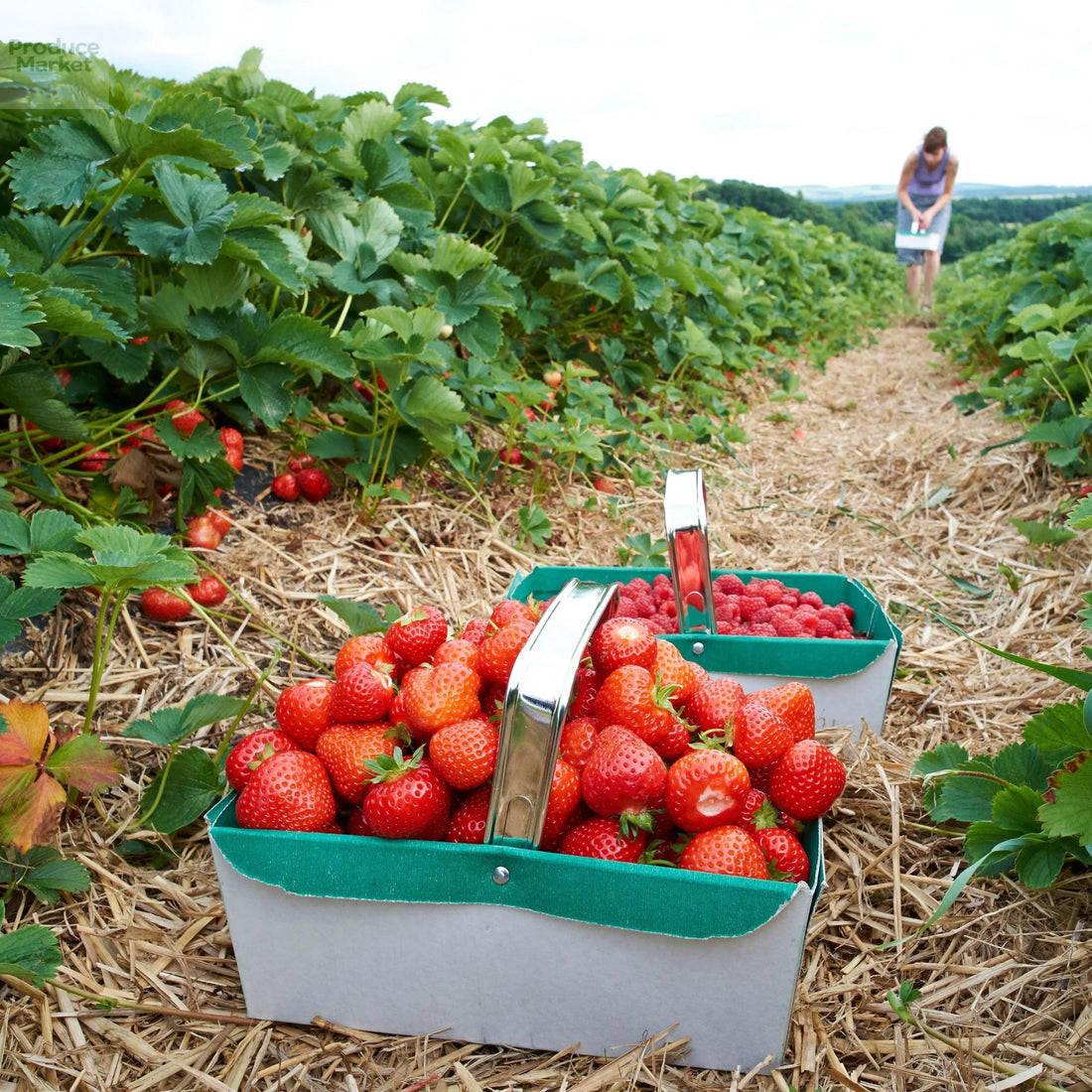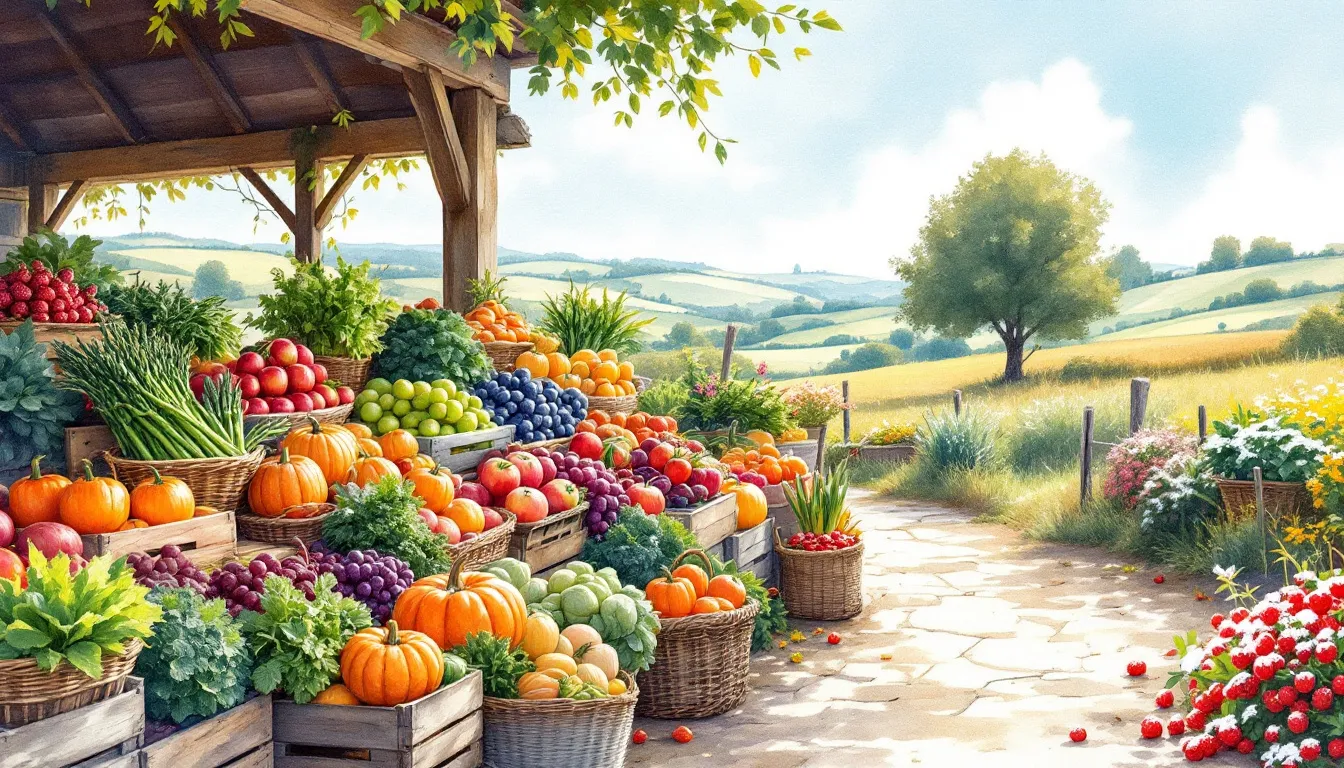
The Best Guide to Seasonal UK Produce: What’s Fresh This Month?
Share
Best Seasonal UK Food: Your Guide to What's In Season Now
Wondering what UK foods are in season right now? Eating seasonally, or enjoying seasonal UK produce, means enjoying fresher, more nutritious options that are kinder to your wallet and the planet. Seasonal produce like brussel sprouts and cucumber are great examples of what you can enjoy during their harvest times. Incorporating a variety of fruit and veg, such as gooseberries, into your diet can further enhance the benefits of seasonal eating. In this guide, discover the top fruits and vegetables available each month, including parsnip and salad leaves, and how they can enhance your meals. Additionally, explore the diverse selection of seasonal foods like swish chard and wild nettles that are available throughout the year.
Introduction to Seasonal Food
Eating seasonally means enjoying foods that are naturally harvested at their peak during specific times of the year. This includes a delightful array of seasonal fruits and vegetables such as apples, carrots, and broccoli. From January to December, the UK offers a diverse selection of seasonal foods, including winter squash, summer squash, and wild mushrooms, ensuring there’s always something fresh and exciting to add to your meals.
The UK’s varied climate allows for a broad range of seasonal foods to be grown, from hearty root vegetables like parsnips and swedes to vibrant leafy greens like kale and spinach. By choosing to eat seasonally, you not only enjoy a variety of delicious and healthy foods, such as strawberries and raspberries, but you also contribute to reducing your carbon footprint and supporting local farmers. This sustainable approach to eating helps promote environmental health and reduces waste.
Embrace the natural rhythm of the seasons and discover the joy of eating seasonally. Whether it’s the crisp sweetness of a freshly picked apple or the earthy richness of wild mushrooms, seasonal food offers a unique and flavorful experience that benefits both you and the planet.
Key Takeaways
-
Eating seasonally enhances flavor and nutrition while being cost-effective and environmentally friendly.
-
Each season provides a diverse array of fruits and vegetables, such as winter staples like carrots and brussels sprouts, and spring delights like fresh radishes, asparagus, cucumber, and gooseberries.
-
Incorporating seasonal foods into your meals supports local farmers and contributes to a sustainable food system, including a variety of fruit and veg like wild nettles.
-
Seasonal vegetables such as brussel sprouts, parsnip, salad leaves, and swish chard support local farmers and sustainability.
Eating Seasonally in the UK

Eating seasonally means enjoying fruits and vegetables that are harvested at their peak ripeness, leading to a host of benefits. Seasonal foods are generally more flavorful, adding an extra dimension to your dishes. Imagine the crispness of a summer courgette, the sweetness of a winter carrot, the refreshing taste of a cucumber, or the tangy burst of gooseberries, each bursting with the flavors of their respective seasons. Not only do they taste better, but they are also fresher, which means they retain more nutrients compared to those that have traveled long distances. Seasonal fruit is a perfect example of this concept.
Consuming seasonal food is also kinder to your wallet and the planet. When you buy produce in season, it’s often more affordable because it’s more abundant. This also means fewer food miles, as the produce doesn’t need to be shipped from far-off places, thus reducing your carbon footprint. Supporting local farmers strengthens the local economy and reduces the environmental impact of food transport. Seasonal fruit and veg, including wild nettles, offer a variety of options that are both affordable and environmentally friendly.
Moreover, eating seasonally encourages a diverse diet. Each season introduces a fresh array of fruits and vegetables, ensuring a varied nutrient intake throughout the year. From spring greens to autumn squashes, brussel sprouts, parsnip, salad leaves, and swish chard, there’s always something new to explore and enjoy.
Embrace the natural rhythm of the seasons to make the most of what each month offers.
Choosing the Best Produce
When selecting seasonal produce, it’s essential to consider factors like freshness, taste, and texture. Whether you’re choosing fruits like pears and plums or vegetables like lettuce and onions, opting for in-season produce ensures you’re getting the most flavorful and nutritious options available. During the summer months, look for broad beans, french beans, and runner beans, which are at their peak and bursting with flavor.
Visiting local farmers’ markets or joining a veg box scheme can provide access to a wide range of seasonal foods, including gourmet delights like morel mushrooms, swiss chard, and jerusalem artichokes. Don’t be afraid to try new and unfamiliar seasonal foods, such as butternut squash or wild garlic, as they can add variety and excitement to your diet.
By choosing the best seasonal produce, you can create delicious and healthy meals. Imagine a fresh salad featuring seasonal leaves like spinach and watercress or a hearty stew made with root vegetables like carrots and parsnips. Embrace the bounty of each season and enjoy the rich flavors and nutritional benefits that come with eating seasonally.
January Seasonal Produce
January might be cold, but it offers a bounty of hearty and nutritious seasonal foods to warm you up. Apples and pears are the seasonal fruits of the month, perfect for pies, crumbles, or simply snacking. When it comes to vegetables, you’ll find an array of options to enrich your winter meals. Beetroot, brussels sprouts, and cabbage are in their prime, providing robust flavors and essential nutrients.
Other vegetables like carrots, celeriac, chicory, kale, leeks, and parsnip are also in season, adding variety to your dishes. Don’t forget the versatile spring greens and spring onions, which can brighten up any meal, and the various types of squash, including butternut and winter squash, that are perfect for comforting soups and roasts.
January’s produce may be humble, but it’s packed with potential to create hearty and satisfying meals.
February Seasonal Produce
As winter continues, February offers a delightful selection of seasonal foods to keep your meals interesting.
Here are some of the seasonal foods available in February:
-
Apples
-
Pears
-
Brussels sprouts
-
Carrots
-
Celeriac
-
Chicory
-
Kale
-
Leeks
-
Parsnip
These ingredients provide a sweet contrast to the savory fennel veg vegetables available, making them staples for winter cooking and adding depth and flavor to your garlic dishes.
February also brings purple sprouting broccoli, red cabbage, and salsify, each offering unique textures and tastes to explore. With such a variety of fruits and vegetables at your disposal, you can create nutritious and delicious meals that celebrate the best of winter produce.
Enjoy February’s flavors and the freshness that seasonal eating brings to your table.
March Seasonal Produce
March marks the transition from winter to spring, bringing an exciting mix of seasonal foods to enjoy. Artichokes, beetroot, carrots, and parsnip continue to be in season, offering vibrant colors and flavors to your meals. Purple sprouting broccoli makes its appearance, adding a splash of color and a burst of nutrients to your plate.
As the days grow longer, you’ll also find fresh radishes, rhubarb, and sorrel in the markets, perfect for adding zing to salads and desserts. Spring greens and spring onions are also in season, providing a taste of the new growth that comes with spring. March’s diverse selection of fruit and vegetables makes it an ideal time to incorporate fresh, seasonal produce into your diet.
April Seasonal Produce
April showers bring a rich variety of seasonal foods, perfect for refreshing your palate after the winter months. New potatoes are among the fresh produce available, offering a tender and flavorful addition to your meals. Morel mushrooms, a highly sought-after seasonal ingredient, add a gourmet touch to any dish.
Kale and various greens like rocket, sorrel, spinach, and salad leaves thrive in April, providing an abundance of leafy options to enhance your salads and sides. Beetroot and carrots are also plentiful, adding vibrant colors and essential nutrients to your diet.
Let the freshness of April’s seasonal foods inspire your spring cooking.
May Seasonal Produce
May is a month of abundance, offering a diverse range of seasonal foods to enjoy. Artichoke, asparagus, and aubergine are in season, providing a variety of flavors and textures for your culinary creations. Beetroot, chillies, lettuce, and salad leaves are also fresh and available, perfect for adding a burst of color and spice to your dishes.
Strawberries begin to appear in May, marking the start of berry season in the UK. Other seasonal produce includes chicory, elderflowers, marrow, new potatoes, peas, peppers, radishes, rhubarb, rocket, samphire, sorrel, spinach, spring greens, spring onions, sweetheart cabbage, and watercress.
May’s wide variety of fruit and vegetables provides an excellent opportunity to explore new recipes and enjoy spring flavors.
June Seasonal Produce
June brings a bounty of fresh and flavorful seasonal foods to your table. Berries like raspberries and strawberries are harvested, offering sweet and juicy treats perfect for desserts and snacks. Rhubarb is still in season, adding a tangy twist to your baking. Asparagus is also available, though it is nearing the end of its season, so enjoy it while you can.
New potatoes are at their peak in June, providing a tender and delicious addition to your meals. Courgettes become increasingly available, adding versatility to your cooking with their mild flavor and firm texture. Salad leaves are plentiful, contributing to the diversity of fresh vegetables you can enjoy. Savor the abundance and freshness of June’s seasonal foods.
July Seasonal Produce
July is a month of plenty, with a variety of seasonal foods to delight your taste buds. Blackberries, blueberries, cherries, and strawberries are in full swing, offering a medley of sweet and tart flavors. Aubergine, beetroot, carrots, tomatoes, peas, and swish chard are also fresh and available, providing a colorful array of vegetables to enhance your meals.
These seasonal foods, whether homegrown or bought from local markets, are perfect for enjoying summer’s best flavors. Incorporate them into your dishes and celebrate the vibrant tastes of July.
August Seasonal Produce
August is a time of abundance, with a variety of seasonal foods to enjoy. Berries like blackberries, cherries, and plums are at their best, offering sweet and juicy flavors perfect for desserts and snacks. Vegetables like sweetcorn, courgettes, aubergines, and swish chard are fresh and available, adding a burst of color and flavor to your dishes.
Broccoli also reaches its peak during August, along with tomatoes, making them great additions to summer salads and cooked dishes. Enjoy the bounty of August with the freshest seasonal foods the UK offers.
September Seasonal Produce
September marks the transition from summer to autumn, bringing a mix of seasonal foods to your table. Apples and pears are in season, perfect for baking or enjoying fresh. Vegetables like broccoli, cauliflower, carrots, and swish chard are also at their best, providing a variety of flavors and nutrients for your meals.
Summer crops including salads, tomatoes, courgettes, cucumbers, and runner beans continue to be productive, offering a taste of the lingering warmth of summer. September’s diverse selection of fruits and vegetables is perfect for embracing the changing seasons and enjoying the best of summer and autumn produce.
October Seasonal Produce
October brings a rich variety of seasonal foods, perfect for hearty autumn meals. Apples and pears are among the key fruits available, ideal for various desserts. Vegetables like kohlrabi, which has a flavor between broccoli and radish, are also in season, adding a unique taste to your dishes.
Other vegetables like brussels sprouts, carrots, swish chard, and various types of summer squash are plentiful, providing the ingredients for warming soups and roasts. Enjoy October’s flavors and the abundance of seasonal foods.
November Seasonal Produce
November offers a bounty of seasonal foods to enjoy as the days grow shorter. Apples and pears are still in season, perfect for baking and snacking. Root vegetables like parsnips and swede are plentiful, providing hearty options for your meals. Brussels sprouts are a key feature of November’s seasonal offerings, adding a festive touch to your dishes.
Kale, butternut squash, cranberries, chestnuts, and swish chard are also widely available, offering a variety of flavors and textures to explore. Savor the richness of November and the best of autumn’s bounty.
December Seasonal Produce
December brings a festive array of seasonal foods to your table. Apples, cranberries, and pears are available, perfect for holiday baking and desserts. Vegetables like beetroot, brussels sprouts, carrots, celeriac, and celery are in season, providing a variety of options for hearty winter dishes.
Chestnuts, chicory, Jerusalem artichokes, and kale are part of other seasonal produce. Additionally, leeks, mushrooms, onions, parsnips, potatoes, pumpkin, red cabbage, swede, Swiss chard, swish chard, turnips, watercress, and winter squash are also included. Enjoy December’s festive flavors and the richness of seasonal foods.
Tips for Eating Seasonally

Eating seasonally can be both enjoyable and rewarding. A community-supported agriculture (CSA) program offers fresh, local produce while supporting local farmers. Local farmers’ markets offer in-season fruit and veg and a chance to connect with growers, making shopping more personal and meaningful.
Planning meals around seasonal ingredients enhances flavor and freshness in your cooking. Canning or freezing seasonal foods like wild nettles helps you enjoy them year-round. Seasonal eating positively impacts environmental health by reducing energy consumption associated with food transport.
Use these tips to make the most of seasonal eat seasonally.
Benefits of Eating Seasonally

Eating seasonally has numerous benefits that go beyond just taste. By reducing food miles and plastic packaging, it directly contributes to climate change mitigation. This means that by choosing seasonal foods, including a variety of fruit and veg, you’re helping to reduce the environmental impact of food transport and packaging.
Moreover, eating seasonally leads to fresher produce as it is harvested at its peak ripeness. This not only enhances the flavor of your meals but also ensures that you’re getting the most nutritional value from your food. For example, incorporating wild nettles into your dishes can provide a unique and fresh taste that is both healthy and sustainable.
Embrace the benefits of eating seasonally and enjoy the freshest, most flavorful produce the UK has to offer.
Seasonal Food and Sustainability
Eating seasonal food is a key aspect of sustainable living. It reduces the demand for out-of-season produce that may be flown in from overseas or grown using intensive farming methods. By supporting local farmers and choosing seasonal foods, you help reduce your carbon footprint and promote more environmentally friendly farming practices. Seasonal fruits like apples and pears, grown locally, are perfect examples of this sustainable approach.
Seasonal food also helps reduce food waste, as it encourages individuals to plan and cook meals around what’s available, rather than relying on imported or out-of-season produce like cucumbers and aubergines. Additionally, eating seasonal food helps preserve traditional farming practices and supports local economies, making it a more sustainable option for those looking to make a positive impact.
Incorporating seasonal foods like brussels sprouts, spring onions, and new potatoes into your diet allows you to enjoy a variety of delicious and healthy meals while promoting sustainability and reducing waste. Embrace the benefits of seasonal eating and contribute to a more sustainable future.
Exploring Seasonal Food Culture
Seasonal food is deeply rooted in UK culture, with many traditional dishes and recipes featuring locally grown and seasonal ingredients. Think of a classic roast dinner with seasonal vegetables or a refreshing summer salad with fresh berries. Exploring seasonal food culture can be a fun and rewarding experience, whether you’re trying new recipes, visiting local farmers’ markets, or attending food festivals that celebrate seasonal fruits and vegetables.
Seasonal food also offers a great way to connect with your local community. Veg box schemes, community gardens, and cooking classes can help you learn more about seasonal foods like purple sprouting broccoli and broad beans. By embracing seasonal food culture, you can develop a deeper appreciation for the food you eat and the people who grow it, making mealtime a more enjoyable and meaningful experience.
Whether you’re enjoying a hearty stew made with seasonal root vegetables or a fresh salad featuring seasonal leaves, exploring seasonal food culture can add richness and variety to your culinary experiences. Make the most of the seasonal foods available in the UK and enjoy the unique flavors and traditions they bring to your table.
Summary
In summary, eating seasonally in the UK offers a delightful journey through the year, with each month bringing its own unique bounty of fruits and vegetables like brussel sprouts, cucumber, and gooseberries. From the hearty root vegetables of January to the festive flavors of December, embracing seasonal fruit and veg, including wild nettles, ensures that you enjoy the freshest, most flavorful produce available. Not only does eating seasonally enhance the taste and nutritional value of your meals, but it also supports local farmers and contributes positively to the environment by including vegetables like parsnip, salad leaves, and swish chard. So, why not start incorporating more seasonal produce into your diet today and experience the full spectrum of flavors that each season has to offer?
Frequently Asked Questions
Why should I eat seasonally?
Eating seasonally means you get the freshest, most flavorful produce while supporting local farmers and helping the environment. Enjoying what's in season is a delicious and sustainable choice!
How can I start eating seasonally?
Eating seasonally is easy and rewarding! Start by visiting local farmers' markets and consider joining a CSA program, while planning your meals around what's in season for the freshest flavors.
What are some tips for preserving seasonal foods?
Canning or freezing your seasonal foods is a fantastic way to enjoy their fresh flavors all year long! By taking this simple step, you can keep that delightful seasonal taste on your table even months later.
